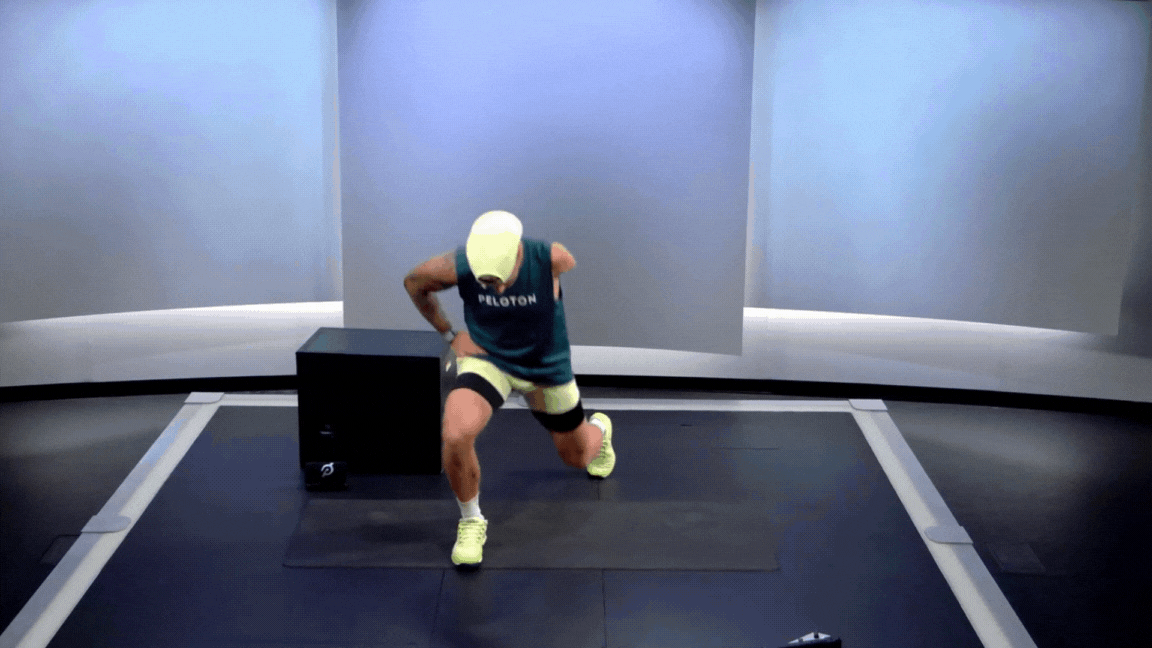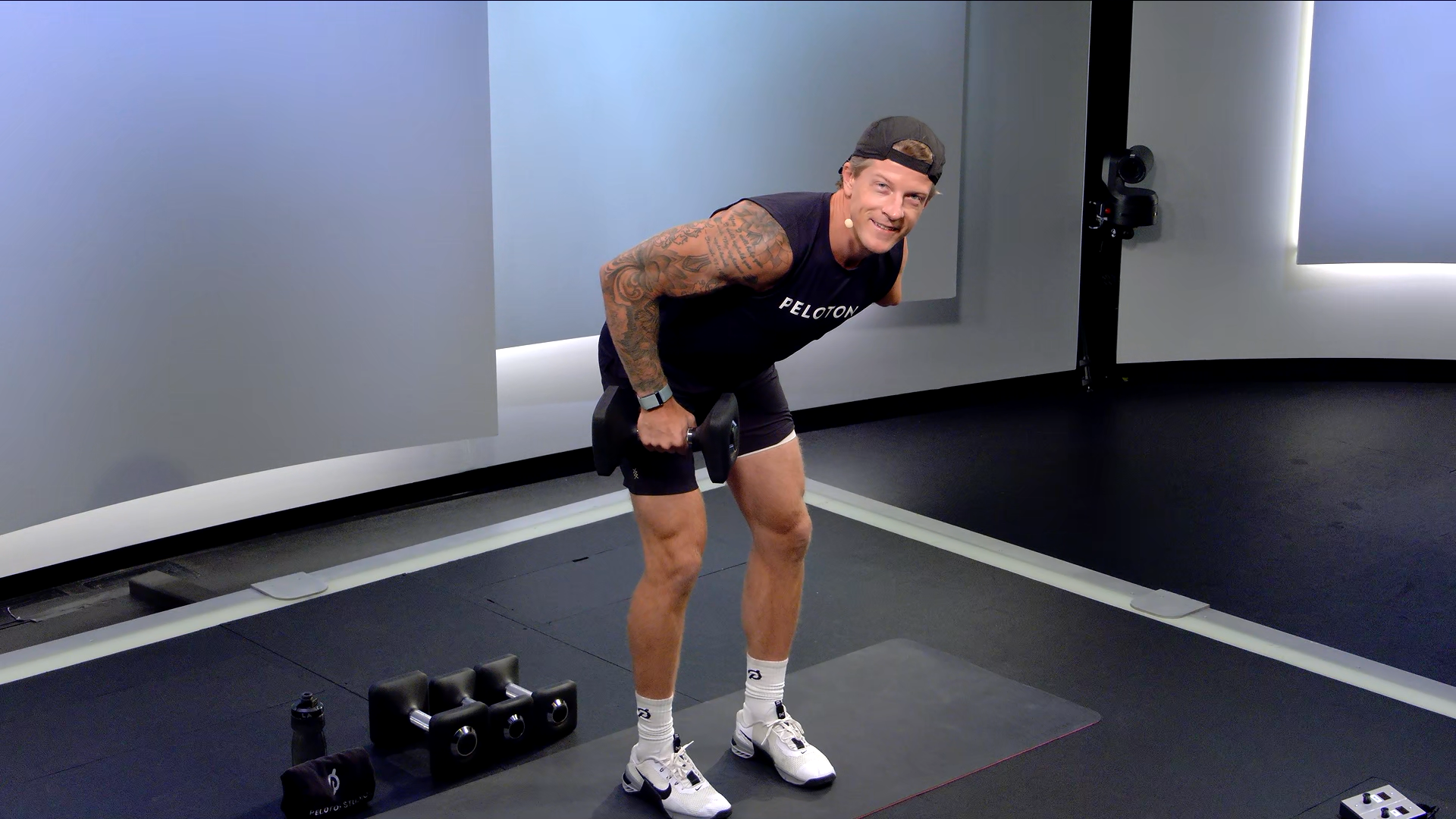What Is Functional Strength Training?
Functional vs. Traditional Strength Training
Benefits of Functional Strength Training
Top Functional Strength Training Moves to Try
Functional Strength Training with Peloton
Peloton strength instructor Logan Aldridge explains why functional strength training is critical to a well-rounded fitness routine and shares some of his favorite functional strength exercises.
Discover more ways to reach your goals with Peloton
There is nothing I value more than a good strength training session. Heavy loads with high-volume reps; nothing makes you feel stronger and fitter. No matter what type of athlete you are or what your fitness level is, strength training is so important when it comes to improving your overall physical performance.
When you break down strength training, it’s simple—and broad. Exercises are done to target specific muscles to increase strength, size, and endurance. Within strength training, however, is a subset called functional training. In fact, it’s a bit of a secret strength training weapon for many Peloton instructors (myself included!).
Here’s a breakdown of everything you need to know about functional strength training, including why you should do it, and how to start.
What Is Functional Strength Training?
Functional strength training is a type of exercise that focuses on training the body for activities performed in daily life, sports, or specific tasks. The primary goal of functional strength training is to improve functional movements and enhance overall functional fitness.
What does that mean, exactly? Think of the little movements you do every day—walking up and down the stairs, picking up a shopping bag, crouching on the floor to play hide and seek with your kids. These are all functional movements, and depending on your functional fitness, you may have limited stamina when it comes to them.
Functional vs. Traditional Strength Training
Functional strength training involves moves that mimic real-life movements (like a bodyweight squat). I love a devil’s press as much as the next person, but thankfully this isn’t a movement that we use in our daily lives!
There is some overlap between functional strength training and traditional strength training. Functional strength training can improve strength because it involves resistance exercises that challenge the body's muscles. Similarly, traditional strength training can enhance functional fitness to an extent because increased strength and muscle capacity benefit daily activities.
The key here is that strength training focuses on isolating individual muscles. This can include moves like:
Shoulder press
Bicep curls
Bent-over rows
Glute bridge
Hollow body hold
Some examples of functional strength training exercises are:
Push-ups
Jump squats
Lateral lunges
Walking lunges
Single leg deadlifts
If you’ve ever done a strength workout on Peloton, chances are you’ve hit moves from both categories. These two schools of training have some overlap. When combined, the result is a balanced workout.

Benefits of Functional Strength Training
There are some distinct advantages to functional strength training. First, it enhances the ability to perform daily tasks better. No one wants to pull a muscle lugging a grocery bag, right? Functional strength training can help you protect your muscles and improve your strength. Here are some other perks to functional training:
Increased Core Strength and Stability
You need your core to do pretty much anything. Yet if you don’t actively engage your core, you’re setting yourself up for injury, per research in Sports Health. Functional exercises (like planks) teach you how to engage the core muscles so that you start to do it naturally. With this comes improved posture and stability.
Better Balance and Coordination
If you find yourself losing your balance, tripping, or just uneven a lot you may think you were just born a klutz. Chances are, you just need to exercise those balance muscles. By using dynamic movements (such as reverse lunges or single-leg deadlifts) you’re lengthening and shortening the muscles in one move, helping them to loosen and tighten. Over time, this can leave you more steady in daily life and in sports and activities. In fact, a review published in Sports Medicine found a direct link between balance ability and improved motor skills (activities like walking, running, and jumping.
Injury Prevention
Functional strength training can help correct muscle imbalances and improve joint stability. This reduces the risk of injuries during daily activities or sports. For example, runners and cyclists should use functional strength training not only to improve performance, but stay in the sport. Squats and lunges will provide power to your lower body. Planks will help stabilize your core to improve your gait when you run and maintain proper posture when cycling.
Glute and Hip Activation
Many functional strength training exercises strengthen the glutes and hips. This is crucial for cyclists and runners when it comes to mechanics. Particularly for when you’re sprinting or climbing, having solid glute and hip strength will give you the extra power you need.
Flexibility and Mobility
There is a lot of dynamic stretching in functional strength training (like walking lunges and scapular push-ups). These stretches zone in on mobility, providing you with more flexibility and a greater range of motion. They also reduce the risk of overuse injuries. Particularly as you age, functional training is an effective way to protect joint mobility and help you stay active.
Greater Calorie Burn
The dynamic nature of functional strength exercises can lead to a higher caloric expenditure compared to isolated strength exercises. That’s because you’re increasing your heart rate while working against resistance. You’re also working more than one muscle at a time, which uses more energy than traditional strength training that focuses on one isolated muscle.
Time Efficiency
If you’ve ever taken a Flash 15 or 20 Minute HIIT Cardio on the Peloton App, you know just how effective you can be in a limited amount of time. Functional strength training is a great way to get in a fast workout because it often involves compound movements that work multiple muscle groups simultaneously.
Top Functional Strength Training Moves to Try
You may find a lot of your strength training workouts include traditional strength exercises and functional strength training moves. If so, great! You’re not only isolating muscles to improve your strength, but you’re also increasing your endurance through functional strength exercises.
If you haven’t experimented with functional strength training yet, here are some exercises to get you started:
1. Squats
Stand with your feet hip-width apart, knees just slightly bent.
Engage your core and slowly lower down, as if you were to sit in an invisible chair. Make sure your knees are staying in line and not collapsing in.
Hold for 3 to 5 seconds and slowly and return to starting position.
Make it harder: In your squat position, engage your core and push through the feet into a jump, extending the legs. Land softly on the balls of the feet and immediately go into another squat. Aim for 10 reps, or 5 standard squats followed by 5 squat jumps.

2. Reverse Lunges
Start with your feet shoulder-width apart, hands on your hips.
Engage your core and take a large step back with your left foot, bending the knee as close to the ground as possible. Your right foot should make a 90-degree angle with the floor.
Press your right foot into the floor to return to the starting position.
Alternate between left and right reverse lunges for 10-20 reps, 5-10 on each side.

3. Single-Leg Deadlifts
Stand with your feet shoulder-width apart and place heavy dumbbells (think 15 lbs. to 20 lbs.) horizontally between your feet. If you’re new to this exercise, start with bodyweight only.
Lean forward, shifting your weight onto the right foot as your left leg extends behind you.
Keeping a slight bend in your right leg, raise the left leg as you bring your arms down, stopping at the middle of your shins.
Engage your glutes and core as you slowly lift back up to starting position.
Repeat for 5-10 reps and switch legs.

4. Push-up
Get into a high plank position, hands under shoulders and feet shoulder-width apart.
Keeping your elbows close to your body, slowly lower your chest down to graze the mat, or as far as you can.
Keeping your elbows rotated in toward the mat (instead of pointing them out), slowly raise up to your starting high plank position. Aim for 5-10 reps with good form.
For beginners, modify this move by starting on your knees first, then progress.

5. Burpees
Starting in a squat, lower hands to the floor outside of your feet.
Jump or step back into a push-up/high plank position.
Complete one push-up. Frog jump feet outside the hands.
Perform one squat jump and returning to your starting squat position. Aim for 5-10 reps without stopping.

6. Step-ups
Using a box, small chair, or stool, step up with the right foot, left leg following.
Bend the right knee and bring the foot back down, followed by the left. Complete 5-10 reps and switch legs.
Make it harder: Hold 10 lb. to 15 lb. dumbbells in each hand as you step up.
7. Plank
Start in tabletop position with your shoulders stacked over your wrists and neck aligned with your spine.
Tuck your toes and then extend your feet behind you, to find a full plank position.
Practice engaging your pelvic floor muscles as you hold your body stable.

Functional Strength Training with Peloton
No matter what fitness level you’re starting at, try to incorporate functional strength training into your workout schedule two to three times a week. If you love strength training, functional strength training doesn’t need to replace it, but it can complement it. Strength training is important for targeting specific muscle groups and building maximal strength, while functional strength training enhances the practical application of that strength in real-life movements and activities.
If you’re interested in functional training, try a full-body strength routine on the Peloton App. It will combine upper and lower body exercises that will help you get stronger and improve your mobility. Start with a bodyweight class first and move on to one with weights as you get stronger and perfect your form.
This content is for informational and educational purposes only and does not constitute individualized advice. It is not intended to replace professional medical evaluation, diagnosis, or treatment. Seek the advice of your physician for questions you may have regarding your health or a medical condition. If you are having a medical emergency, call your physician or 911 immediately.
Level up your inbox.
Subscribe for a weekly dose of fitness, plus the latest promos, launches, and events.
By providing your email address, you agree to receive marketing communications from Peloton.
For more about how we use your information, see our Privacy Policy.






